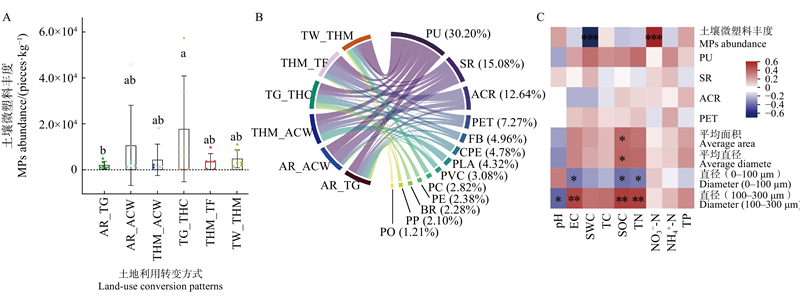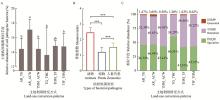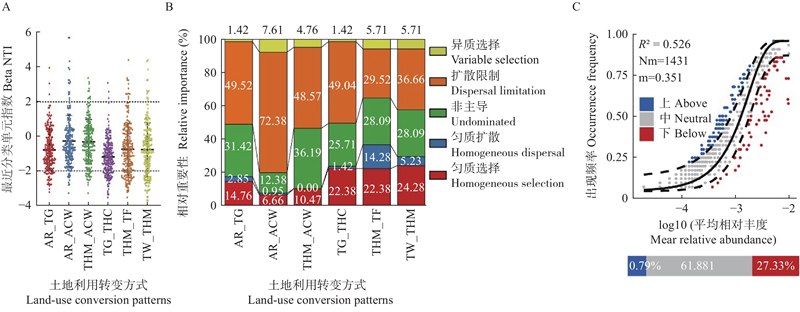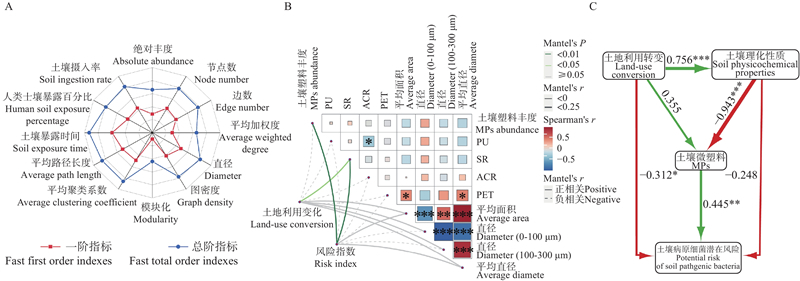

林业科学 ›› 2025, Vol. 61 ›› Issue (7): 231-240.doi: 10.11707/j.1001-7488.LYKX20230711
王参1,2( ),Masoudi Abolfazl3,王敏4,张泽1,曹靖锟1,徐雨豪2,于志军1,*(
),Masoudi Abolfazl3,王敏4,张泽1,曹靖锟1,徐雨豪2,于志军1,*( ),刘敬泽1,*(
),刘敬泽1,*( )
)
收稿日期:2024-11-23
出版日期:2025-07-20
发布日期:2025-07-25
通讯作者:
于志军,刘敬泽
E-mail:wangcan@hebtu.edu.cn;yzj116@163.com;liujingze@hebtu.edu.cn
基金资助:
Can Wang1,2( ), Masoudi Abolfazl3,Min Wang4,Ze Zhang1,Jingkun Cao1,Yuhao Xu2,Zhijun Yu1,*(
), Masoudi Abolfazl3,Min Wang4,Ze Zhang1,Jingkun Cao1,Yuhao Xu2,Zhijun Yu1,*( ),Jingze Liu1,*(
),Jingze Liu1,*( )
)
Received:2024-11-23
Online:2025-07-20
Published:2025-07-25
Contact:
Zhijun Yu,Jingze Liu
E-mail:wangcan@hebtu.edu.cn;yzj116@163.com;liujingze@hebtu.edu.cn
摘要:
目的: 明确雄安新区典型土地利用转变方式下土壤微塑料和病原细菌群落特征,揭示土壤微塑料对土壤病原细菌潜在风险的影响,为土壤微塑料和病原细菌的防控提供科学依据。方法: 以雄安新区6种典型土地利用转变方式土壤为研究对象,采用激光红外成像技术和三代高通量测序方法,分析土壤微塑料和病原细菌群落的特征,结合环境微生物定量风险评估方法,识别土壤病原细菌对人体健康的潜在风险,并阐明土地利用转变方式、土壤理化性质以及微塑料丰度、组成和形态对病原细菌风险指数的影响。结果: 建设用地土壤中微塑料平均丰度显著高于其他土地利用类型,聚氨酯(PU)和硅树脂(SR)是雄安新区典型土地利用方式下的主要微塑料类型;土壤微塑料丰度与病原细菌风险指数以及土壤NO3?-N显著正相关,与土壤含水量(SWC)呈显著负相关。土壤的碱性环境有利于SR、丙烯酸酯共聚物(ACR)和聚对苯二甲酸乙二酯(PET)等微塑料的富集。雄安新区6种典型土地利用方式中,土壤动物病原细菌类群丰度显著高于人畜共患类和植物类。建设用地土壤中病原细菌的特化种丰度在6种土地利用方式中最高,菌群异质化水平较高,菌群间合作程度较强,对人类健康的潜在风险较高。结论: 土地利用转变方式直接影响土壤病原细菌对人类健康的潜在风险,突显白洋淀生态环境治理在防控土壤病原细菌污染方面的重要作用。然而,建设过程中富集的微塑料颗粒(如聚乙烯、聚丙烯、聚氯乙烯和PET等)、农田土壤控释肥残膜和石油化工废水的残留(如PU和SR),进一步加剧了土壤病原细菌对人类健康的潜在风险。
中图分类号:
王参,Masoudi Abolfazl,王敏,张泽,曹靖锟,徐雨豪,于志军,刘敬泽. 雄安新区典型土地利用转变方式下土壤病原细菌特征及其对微塑料的响应[J]. 林业科学, 2025, 61(7): 231-240.
Can Wang, Masoudi Abolfazl,Min Wang,Ze Zhang,Jingkun Cao,Yuhao Xu,Zhijun Yu,Jingze Liu. Characteristics of Soil Pathogenic Bacteria and Their Response to Microplastics under Typical Land-use Conversion Patterns in Xiong’an New Area[J]. Scientia Silvae Sinicae, 2025, 61(7): 231-240.
表1
典型土地利用转变方式和样品信息①"
| 土地利用转变方式 Land-use conversion patterns | 土地利用现状分类(一级类) Current land use classification (first category) | 生境类型 Habitat types | 样品名 Sample name | 采样坐标点 Sampling sites |
| 水稻田→草地 Rice paddy → Grassland | 耕地→草地 Farmland → Grassland | 水生→陆生 Aquatic habitat → Terrestrial habitat | AR_TG | 38°53′17″N,115°45′34″E |
| 水稻田→人工湿地(主要植物为芦苇) Rice paddy → Constructed wetland (the main plant is Phragmites australis) | 耕地→水域用地 Farmland → Wetland | 陆生→水生 Terrestrial habitat → Aquatic habitat | AR_ACW | 38°54′07″N,115°48′12″E |
| 玉米地 →人工湿地(主要植物为芦苇)Maize land → Constructed wetland (the main plant is Phragmites australis) | 耕地→水域用地 Farmland → Wetland | 陆生→水生 Terrestrial habitat → Aquatic habitat | THM_ACW | 38°53′59″N,115°47′25″E |
| 草地→建设用地 Grassland → Urban infrastructure construction | 草地→商服用地/住宅用地/公共管理与公共服务用地 Grassland → Commercial and service land / residential land / public administration and public service land | 无变化 No change | TG_THC | 39°03′26″N,115°55′16″E |
| 玉米地→林地(杜仲) Maize land → Plantation (Eucommia ulmoides) | 耕地→林地 Farmland → Woodland | 无变化 No change | THM_TF | 38°53′39″N,115°45′02″E |
| 小麦地→玉米地(轮作) Wheat land → Maize land (rotation) | 耕地→耕地 Farmland →Farmland | 无变化 No change | TW_THM | 38°56′15″N,115°45′31″E |

图1
雄安新区典型土地利用转变方式土壤微塑料丰度(A)、聚合物类型占比(B)与土壤理化性质关系(C) 不同小写字母表示差异显著(P<0.05)。Different lowercase letters indicate significant differences (P<0.05). MPs:微塑料Microplastics;AR_TG:水稻田转变为草地Rice paddy converted into grassland;AR_ACW:水稻田转变为人工湿地Rice paddy converted into constructed wetland;THM_ACW:玉米地转变为人工湿地Maize land converted into constructed wetland;TG_THC:草地转变为建设用地Grassland converted into urban infrastructure construction;THM_TF:玉米地转变为林地Maize paddy converted into plantation;TW_THM:小麦地转变为玉米地Wheat land converted into maize land;PU:聚氨酯Polyurethane;SR:硅树脂Silicone resin;ACR:丙烯酸酯共聚物Acrylate copolymer;PET:聚对苯二甲酸乙二酯Polyethylene terephthalate;FB:氟橡胶Fluororubber;CPE:氯化聚乙烯Chlorinated polyethylene;PLA:聚乳酸Polylactic acid;PVC:聚氯乙烯Polyvinylchloride;PC:聚碳酸酯Polycarbonate;PE:聚乙烯Polyethylene;BR:顺丁橡胶Butadiene rubber;PP:聚丙烯Polypropylene;PO:聚丁二烯Polybutadiene;EC:土壤电导率Soil electrical conductivity;SWC:土壤含水量Soil water content;TC:土壤全碳Soil total carbon;SOC:土壤有机碳Soil organic carbon;TN:土壤全氮Soil total nitrogen;NO3−-N:土壤硝态氮Soil nitrate nitrogen;NH4+-N:土壤铵态氮Soil ammonium nitrogen;TP:土壤全磷Soil total phosphorus. *、**和***分别表示P<0.05、P<0.01和P<0.001水平差异显著。*, **, and *** indicate significant difference with P<0.05, P<0.01, and P<0.001, respectively."


图2
雄安新区典型土地利用转变方式土壤病原细菌相对丰度(A),动物、植物、人畜共患病原细菌群落Shannon指数(B)和特化种、泛化种、中性类群的相对丰度(C) AR_TG:水稻田转变为草地Rice paddy converted into grassland;AR_ACW:水稻田转变为人工湿地Rice paddy converted into constructed wetland;THM_ACW:玉米地转变为人工湿地Maize land converted into constructed wetland;TG_THC:草地转变为建设用地Grassland converted into urban infrastructure construction;THM_TF:玉米地转变为林地Maize paddy converted into plantation;TW_THM:小麦地转变为玉米地Wheat land converted into maize land. 不同小写字母表示差异显著(P<0.05)。Different lowercase letters indicate significant differences (P<0.05). *、**和***分别表示在P<0.05、P<0.01和P<0.001水平差异显著。*, **, and *** indicate significant difference with P<0.05, P<0.01, and P<0.001, respectively."

表2
雄安新区典型土地利用类型土壤动物、植物和人畜共患病原细菌Alpha多样性,中性群落模型的群落构建过程和基于βMNTD、Bray-Curtis、Jaccard距离的群落不相似性①"
| 指数Index | AR_TG | AR_ACW | THM_ACW | TG_THC | THM_TF | TW_THM | |
| Alpha多样性 Alpha diversity | 动物Animal | 2.419 ± 0.254a | 2.481 ± 0.207a | 2.460 ± 0.1626a | 2.446 ± 0.651a | 2.491 ± 0.11685a | 2.526 ± 0.239a |
| 植物Plant | 1.076 ± 0.491a | 1.223 ± 0.096a | 1.264 ± 0.092a | 1.143 ± 0.351a | 1.315 ± 0.210a | 1.262 ± 0.360a | |
| 人畜共患Zoonotic | 1.458 ± 0.292a | 1.467 ± 0.276a | 1.563 ± 0.293a | 1.604 ± 0.257a | 1.577 ± 0.167a | 1.566 ± 0.238a | |
| 群落构建过程 Community assembly | m (NCM) | 0.742 | 0.857 | 1.011 | 0.497 | 1.134 | 1.173 |
| R2 (NCM) | 0.244 | 0.208 | 0.264 | 0.208 | 0.284 | 0.275 | |
| 群落不相似性 Community dissimilarity | βMNTD | 0.052 ± 0.009b | 0.056 ± 0.009b | 0.044 ± 0.005c | 0.076 ± 0.032a | 0.040 ± 0.004c | 0.037 ± 0.004c |
| Bray-Curtis | 0.502 ± 0.103bc | 0.514 ± 0.108b | 0.455 ± 0.050c | 0.630 ± 0.148a | 0.334 ± 0.049e | 0.387 ± 0.062d | |
| Jaccard | 0.600 ± 0.060b | 0.599 ± 0.041b | 0.530 ± 0.022c | 0.653 ± 0.118a | 0.492 ± 0.036d | 0.519 ± 0.031cd | |

图3
基于中性模型的土壤病原细菌群落构建过程(A)和生态过程占比(B)及基于中性群落模型的土壤病原细菌群落构建过程(C) AR_TG:水稻田转变为草地Rice paddy converted into grassland;AR_ACW:水稻田转变为人工湿地Rice paddy converted into constructed wetland;THM_ACW:玉米地转变为人工湿地Maize land converted into constructed wetland;TG_THC:草地转变为建设用地Grassland converted into urban infrastructure construction;THM_TF:玉米地转变为林地Maize paddy converted into plantation;TW_THM:小麦地转变为玉米地Wheat land converted into maize land. R2代表了中性群落模型的整体拟合优度,Nm是宏群落规模(N)与迁移率(m)的乘积。The coefficient of determination (R2) is the goodness of fit of the neutral model. Nm indicates the estimates of the metacommunity size (N) times immigration rate (m)."


图4
雄安新区典型土地利用转变方式土壤风险指标的全局敏感性分析(A)、土壤风险指数与土壤微塑料曼特尔检验(B)和偏最小二乘路径模型结果(C) *、**和***分别表示在P<0.05、P<0.01和P<0.001水平差异显著。*, **, and *** indicate significant difference with P<0.05, P<0.01, and P<0.001, respectively. 偏最小二乘路径模型的拟合优度值和R2分别为0.660和0.601。The value of GOF (Goodness of fitness) and R2 about PLS-PM are 0.660 and 0.601, respectively."

表3
雄安新区典型土地利用转变方式土壤病原细菌共现性网络拓扑参数和风险指数①"
| 土壤病原细菌风险评价指标 Indicators of soil pathogenic bacteria risk evaluation | AR_TG | AR_ACW | THM_ACW | TG_THC | THM_TF | TW_THM | 综合加权值 Comprehensive weight |
| 绝对丰度 Absolute abundance | 0.093 | ||||||
| 节点数 Node number | 134 | 141 | 172 | 73 | 206 | 210 | 0.114 |
| 边数 Edge number | 797 | 801 | 363 | 0.157 | |||
| 正相关关系占比 Proportion of positive correlation | 53.7% | 58.8% | 53.19% | 72.73% | 55.59% | 62.12% | / |
| 负相关关系占比 Proportion of negative correlation | 46.3% | 41.2% | 46.81% | 27.27% | 44.41% | 37.88% | / |
| 平均加权度 Average weighted degree | 10.516 | 10.015 | 11.336 | 8.807 | 12.478 | 13.661 | 0.050 |
| 直径 Diameter | 7 | 7 | 6 | 10 | 6 | 6 | 0.071 |
| 图密度 Graph density | 0.089 | 0.081 | 0.076 | 0.138 | 0.069 | 0.074 | 0.091 |
| 模块化 Modularity | 0.502 | 0.543 | 0.530 | 0.435 | 0.586 | 0.501 | 0.029 |
| 平均聚类系数 Average clustering coefficient | 0.505 | 0.495 | 0.503 | 0.578 | 0.488 | 0.487 | 0.022 |
| 平均路径长度 Average path length | 3.047 | 3.099 | 3.033 | 3.162 | 2.966 | 2.956 | 0.008 |
| 土壤暴露时间 Soil exposure time/(mg·d-1) | 130 | 80 | 100 | 150 | 200 | 220 | 0.129 |
| 人类土壤暴露百分比 Human soil exposure percentage (%) | 45 | 25 | 30 | 50 | 56 | 68.7 | 0.120 |
| 土壤摄食率 Soil ingestion rate/(mg·d-1) | 90 | 50 | 70 | 100 | 120 | 130 | 0.110 |
| 风险指数 Risk index | 0.388 | 0.274 | 0.286 | 0.751 | 0.401 | 0.433 | / |
| 白雪娟, 翟国庆, 刘敬泽. 13C稳定同位素在陆地生态系统植物-微生物-土壤碳循环中的应用. 林业科学, 2024, 60 (7): 175- 190. | |
| Bai X J, Zhai G Q, Liu J Z. Application of 13C stable isotopes in plant-microbial-soil carbon cycle in terrestrial ecosystem. Scientia Silvae Sinicae, 2024, 60 (7): 175- 190. | |
| 丛 微, 于晶晶, 喻海茫, 等. 不同气候带森林土壤微生物多样性和群落构建特征. 林业科学, 2022, 58 (2): 70- 79. | |
| Cong W, Yu J J, Yu H M, et al. Diversity and community assembly of forest soil microorganisms in different climatic zones. Scientia Silvae Sinicae, 2022, 58 (2): 70- 79. | |
| 戴柳云, 侯 磊, 王 化, 等. 2024. 土地利用对洱海罗时江小流域土壤微塑料污染的影响. 环境科学, 45(5): 3069−3077. | |
| Dai L Y, Hou L, Wang H, et al. 2024. Effects of land use patterns on soil microplastic pollution in the Luoshijiang subwatershed of Erhai Lake basin. Environmental Science, 45(5): 3069-3077. [in Chinese]) | |
| 侯军华, 檀文炳, 余 红, 等. 土壤环境中微塑料的污染现状及其影响研究进展. 环境工程, 2020, 38 (2): 16- 27,15. | |
| Hou J H, Tan W B, Yu H, et al. Microplastics in soil ecosystem: a review on sources, fate and ecological impact. Environmental Engineering, 2020, 38 (2): 16- 27,15. | |
| 郝永丽, 胡亚鲜, 白晓雄, 等. 黄土高原土地利用方式对微塑料丰度和形态分布的影响. 环境科学, 2022, 43 (9): 4748- 4755. | |
| Hao Y L, Hu Y X, Bai X X, et al. Abundances and morphology patterns of microplastics under different land use types on the Loess Plateau. Environmental Science, 2022, 43 (9): 4748- 4755. | |
| 王 参. 2022. 雄安新区不同土地利用方式土壤微生物群落特征及其影响因子研究. 石家庄: 河北师范大学. | |
| Wang C. 2022. Studies on soil microbial community characteristics and their influencing factors under different land-use patterns in the Xiong'an New Area. Shijiazhuang: Hebei Normal University. [in Chinese] | |
| 王 参, Abolfazl M, 杨 佳, 等. 短时间尺度雄安新区旱柳根际土壤细菌群落特征分析. 生态学报, 2023, 43 (2): 858- 867. | |
| Wang C, Abolfazl M, Yang J, et al. Bacterial rhizospere characteristics of Salix matsudana under short time scale in the Xiong'an New Area, China. Acta Ecologica Sinica, 2023, 43 (2): 858- 867. | |
| 张万益, 贾德龙, 王 尧, 等. 地质调查: 雄安新区建设先“摸底”. 中国发展观察, 2017, (8): 22- 23. | |
| Zhang W Y, Jia D L, Wang Y, et al. Geological survey: xiong'an new area construction should be “thoroughly explored”. China Development Observation, 2017, (8): 22- 23. | |
| 朱永官, 陈保冬, 付 伟. 土壤生态学研究前沿. 科技导报, 2022, 40 (3): 25- 31. | |
| Zhu Y G, Chen B D, Fu W. Research frontiers in soil ecology. Science & Technology Review, 2022, 40 (3): 25- 31. | |
|
Banerjee S, van der Heijden M G A. Soil microbiomes and one health. Nature Reviews Microbiology, 2023, 21 (1): 6- 20.
doi: 10.1038/s41579-022-00779-w |
|
| Carpenter E, Smith K L. 1972. Plastics on the Sargasso Sea surface. Science, 175(4027): 1240–1241. | |
|
Choi Y R, Kim Y N, Yoon J H, et al. Plastic contamination of forest, urban, and agricultural soils: a case study of Yeoju city in the Republic of Korea. Journal of Soils and Sediments, 2021, 21 (5): 1962- 1973.
doi: 10.1007/s11368-020-02759-0 |
|
|
Christel A, Dequiedt S, Chemidlin-Prevost-Bouré N, et al. Urban land uses shape soil microbial abundance and diversity. Science of the Total Environment, 2023, 883, 163455.
doi: 10.1016/j.scitotenv.2023.163455 |
|
| Deng L Y, Xi H B, Wan C L, et al. 2023. Is the petrochemical industry an overlooked critical source of environmental microplastics? Journal of Hazardous Materials, 451: 131199. | |
|
He X K, Qian Y B, Li Z L, et al. Identification of factors influencing the microplastic distribution in agricultural soil on Hainan Island. Science of the Total Environment, 2023, 874, 162426.
doi: 10.1016/j.scitotenv.2023.162426 |
|
|
Hu J, Zhang L Q, Zhang W Y, et al. Significant influence of land use types and anthropogenic activities on the distribution of microplastics in soil: a case from a typical mining-agricultural city. Journal of Hazardous Materials, 2024, 477, 135253.
doi: 10.1016/j.jhazmat.2024.135253 |
|
|
Leslie H A, van Velzen M J M, Brandsma S H, et al. Discovery and quantification of plastic particle pollution in human blood. Environment International, 2022, 163, 107199.
doi: 10.1016/j.envint.2022.107199 |
|
| Li C C, Liu J, Rillig M C, et al. 2024a. What harmful microbes are lurking in the world’s 7 billion tonnes of plastic waste? Nature, 634(8032): 30-32. | |
|
Li M, Chen L D, Zhao F K, et al. An innovative risk evaluation method on soil pathogens in urban-rural ecosystem. Journal of Hazardous Materials, 2023, 459, 132286.
doi: 10.1016/j.jhazmat.2023.132286 |
|
|
Li Z P, Shangguan H Y, Yao H F, et al. Colonization ability and uniformity of resources and environmental factors determine biological homogenization of soil protists in human land-use systems. Global Change Biology, 2024b, 30 (7): e17411.
doi: 10.1111/gcb.17411 |
|
|
Liu Y H, Xiao M L, Shahbaz M, et al. Microplastics in soil can increase nutrient uptake by wheat. Journal of Hazardous Materials, 2022, 438, 129547.
doi: 10.1016/j.jhazmat.2022.129547 |
|
|
Masoudi A, Wang M, Zhang X L, et al. Meta-analysis and evaluation by insect-mediated baiting reveal different patterns of hypocrealean entomopathogenic fungi in the soils from two regions of China. Frontiers in Microbiology, 2020, 11, 1133.
doi: 10.3389/fmicb.2020.01133 |
|
| Okeke E S, Okoye C O, Atakpa E O, et al. 2022. Microplastics in agroecosystems-impacts on ecosystem functions and food chain. Resources, Conservation and Recycling, 177: 105961. | |
|
Pepper I L. The soil health-human health nexus. Critical Reviews in Environmental Science and Technology, 2013, 43 (24): 2617- 2652.
doi: 10.1080/10643389.2012.694330 |
|
| Rillig M C. 2012. Microplastic in terrestrial ecosystems and the soil? Environmental Science & Technology, 46(12): 6453-6454. | |
|
Sarkar A, McInroy C J A, Harty S, et al. Microbial transmission in the social microbiome and host health and disease. Cell, 2024, 187 (1): 17- 43.
doi: 10.1016/j.cell.2023.12.014 |
|
| Thompson R C, Olsen Y, Mitchell R P, et al. 2004. Lost at sea: where is all the plastic? Science, 304(5672): 838. | |
|
Wang C, Masoudi A, Wang M, et al. Stochastic processes drive the dynamic assembly of bacterial communities in Salix matsudana afforested soils. Frontiers in Microbiology, 2024a, 15, 1467813.
doi: 10.3389/fmicb.2024.1467813 |
|
|
Wang C, Masoudi A, Wang M, et al. Land-use types shape soil microbial compositions under rapid urbanization in the Xiong'an New Area, China. Science of the Total Environment, 2021, 777, 145976.
doi: 10.1016/j.scitotenv.2021.145976 |
|
|
Wang C, Masoudi A, Wang M, et al. Community structure and diversity of the microbiomes of two microhabitats at the root-soil interface: implications of meta-analysis of the root-zone soil and root endosphere microbial communities in Xiong'an New Area. Canadian Journal of Microbiology, 2020, 66 (11): 605- 622.
doi: 10.1139/cjm-2020-0061 |
|
|
Wang M, Masoudi A, Wang C, et al. Impacts of net cages on pollutant accumulation and its consequence on antibiotic resistance genes (ARGs) dissemination in freshwater ecosystems: insights for sustainable urban water management. Environment International, 2024b, 183, 108357.
doi: 10.1016/j.envint.2023.108357 |
|
| Wang M, Masoudi A, Wang C, et al. Plantation type and afforestation age disclose variable influences on soil microbial compositions in man‐made forests in the Xiong'an New Area, China. Land Degradation & Development, 2022, 33, 3058- 3073. | |
| Wang M, Wang C, Yu Z J, et al. 2023. Fungal diversities and community assembly processes show different biogeographical patterns in forest and grassland soil ecosystems. Frontiers in Microbiology, 14: 1036905. | |
|
Withana P A, Li J, Senadheera S S, et al. Machine learning prediction and interpretation of the impact of microplastics on soil properties. Environmental Pollution, 2024, 341, 122833.
doi: 10.1016/j.envpol.2023.122833 |
|
|
Wu C H, Wang M, Wang C, et al. Reed biochar improved the soil functioning and bacterial interactions: a bagging experiment using the plantation forest soil (Fraxinus chinensis) in the Xiong'an New Area, China. Journal of Cleaner Production, 2023, 410, 137316.
doi: 10.1016/j.jclepro.2023.137316 |
|
|
Yang X R, Jiang G F, Zhang Y Z, et al. MBPD: a multiple bacterial pathogen detection pipeline for one health practices. iMeta, 2023, 2 (1): e82.
doi: 10.1002/imt2.82 |
|
|
Zhai Y J, Bai J H, Chang P F, et al. Microplastics in terrestrial ecosystem: exploring the menace to the soil-plant-microbe interactions. TrAC Trends in Analytical Chemistry, 2024, 174, 117667.
doi: 10.1016/j.trac.2024.117667 |
|
|
Zhang F D, Yang X Y, Zhang Z M. Effects of soil properties and land use patterns on the distribution of microplastics: a case study in southwest China. Journal of Environmental Management, 2024, 356, 120598.
doi: 10.1016/j.jenvman.2024.120598 |
|
|
Zhang P, Wang J, Huang L, et al. Microplastic transport during desertification in drylands: abundance and characterization of soil microplastics in the amu darya-Aral sea basin, central Asia. Journal of Environmental Management, 2023, 348, 119353.
doi: 10.1016/j.jenvman.2023.119353 |
|
| Zhang S Y, He Z Z, Wu C Y, et al. Complex bilateral interactions determine the fate of polystyrene micro- and nanoplastics and soil protists: implications from a soil Amoeba. Environmental Science & Technology, 2022, 56 (8): 4936- 4949. | |
|
Zhao M, Li Y F, Li C P, et al. Effects of polyurethane microplastics combined with cadmium on maize growth and cadmium accumulation under different long-term fertilisation histories. Journal of Hazardous Materials, 2024, 473, 134726.
doi: 10.1016/j.jhazmat.2024.134726 |
| [1] | 王军辉,丁昌俊,李伟,罗克明,王君,张伟溪,钮世辉,张苗苗,赵曦阳,薛良交,殷恒福. 2024年中国林木遗传育种研究进展[J]. 林业科学, 2025, 61(7): 35-51. |
| [2] | 刘玉闯,刘嘉辉,赵健,赵东,张宏业,苏小康,冯裕科,程延,李梓仪. 枸杞机械化采收相关理论与装备研究进展[J]. 林业科学, 2025, 61(5): 222-232. |
| [3] | 陈丽霞,程雅畅,路峰,岳修鹏,张国钢,孙戈. 东方白鹳卫星跟踪时长的影响因素分析[J]. 林业科学, 2025, 61(5): 180-186. |
| [4] | 白涵,郝珉辉,何怀江,张新娜,张春雨,赵秀海. 东北主要树种幼树叶片功能性状对模拟氮沉降的响应[J]. 林业科学, 2025, 61(5): 23-32. |
| [5] | 王旭,郭昊,宝音满达,周光益,陈跃华,李党仁. 极端干旱条件下亚热带杉木人工混交林林木受损特征及影响因素[J]. 林业科学, 2025, 61(5): 12-22. |
| [6] | 张铭佳,仝伯强,曲凯,咸洋,崔程程,王永正,臧一村,韩彪. 麻栎种子和胚方脱水敏感性及其低温贮藏技术[J]. 林业科学, 2025, 61(4): 129-139. |
| [7] | 马欣欣,王游,王佳军,冯龙,马建锋. 热解过程中竹材灰分组成变化及硅的转化分布规律[J]. 林业科学, 2025, 61(2): 172-179. |
| [8] | 朱颖,周昕宇,冯育青,汪辉,李欣. 水网城市湿地生态网络韧性评价——以苏州中心城区为例[J]. 林业科学, 2025, 61(2): 62-73. |
| [9] | 崔桂鹏,党宏忠,熊伟,王锋,李永华,姚斌,崔梦淳,孔维远,卢琦. 对“三北”工程区退化林修复策略的思考[J]. 林业科学, 2025, 61(1): 10-16. |
| [10] | 姜清彬,孟景祥,李保军,陈海军,方碧江,郭朗,田生辉. 8年生火力楠半同胞家系遗传评价与选育[J]. 林业科学, 2025, 61(1): 104-114. |
| [11] | 杨淑雅,王镜如,朱滢滢,伊力塔,刘美华. 杉木与浙江楠混交对根系分泌物和丛枝菌根真菌群落结构的影响[J]. 林业科学, 2024, 60(9): 59-68. |
| [12] | 陈丽霞,路峰,江红星,孙戈,岳修鹏,王艺璇,高彤,胡兴波,丁长青. 基于卫星跟踪的黄河三角洲东方白鹳适宜栖息地分布预测[J]. 林业科学, 2024, 60(8): 46-56. |
| [13] | 包广道,刘婷,张忠辉,任志彬,翟畅,丁铭铭,姜雪菲. 长白山区4种针叶林有效叶面积指数遥感精细反演及空间分布规律[J]. 林业科学, 2024, 60(5): 127-138. |
| [14] | 王霞,曹银珠,武华峰,刘道凤,眭顺照. 蜡梅转录因子 CpBBX24 基因的克隆及功能分析[J]. 林业科学, 2024, 60(4): 127-135. |
| [15] | 吕梓晴, 段爱国. 不同产区杉木生物量与碳储量模型[J]. 林业科学, 2024, 60(2): 1-11. |
| 阅读次数 | ||||||
|
全文 |
|
|||||
|
摘要 |
|
|||||